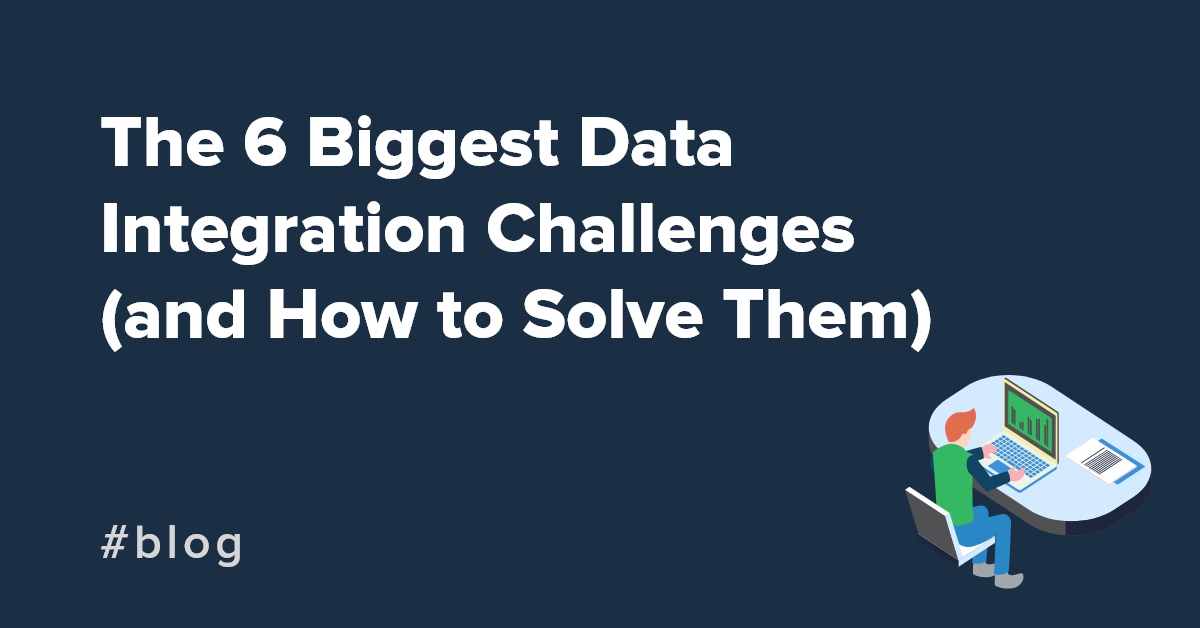Data integration offers a breadth of valuable information that lets your business implement new innovative services. But data integration doesn’t come without data integration challenges to overcome.
Without the right mindset, technology or strategy, the way you handle your data could be hindering your BI, analytics and innovation goals. The result? A stagnant organization that falls behind its competitors and fails to meet client demand.
But what can your organization do to avoid this fate? Well, you need to avoid the 6 biggest data integration challenges.
Data integration challenges:
Before we get stuck into the core issues, let’s first define exactly what we mean by a ‘data integration challenge’.
Download the article as a pdf
Share it with colleagues. Print it as a booklet. Read it on the plane.
What is a data integration challenge?
Here is a definition of data integration challenge: a data integration challenge is something stopping you from achieving control over the processes and output of your data integration. It's the boulder in your way from getting a single, unified view of your data.
And what's data integration? Data integration involves retrieving data from disparate sources and merging it together to create a single, unified view. This unification makes it easier to draw insights from your data that, when acted upon, can deliver faster, more meaningful business growth.
Of course, data integration challenges can come under many labels - data integration problems, data integration issues - but they always point to the same thing.
Getting on top of data integration challenges is important when data processing at scale and when working to mature your data strategy.
6 biggest data integration challenges you can’t ignore
Now that we’ve given you a broad overview of what a data integration challenge is, let’s look more specifically at few commonplace examples.
Here are six data integration challenges your business may face and some ideas on how to solve them.
1. Your data isn’t where you need it to be
You want your data in one centralized place, but you struggle with the execution. Sound familiar?
This data integration challenge is commonly a result of depending on human power alone. Relying on developers to curate data from disparate sources and combine it takes time. And this is time that your organization should be spent on analyzing data insights and driving valuable business practices.
So, to cut out the middleman and speed up your innovation goals, it’s better to enlist the help of a smart data integration platform. This will do most of the heavy lifting for you. It's a great way to say goodbye to data your data integration issues.
2. Your data is there, but it’s late
Some processes require real-time or near real time data collection. For instance, if you’re a retailer running an e-commerce site, you may choose to display tailored, targeted ads to each individual customer based on their search history. This is another painful data integration problem.
But, if your data isn’t collected in the timespan you expect, you can’t meet these demands. Unfortunately, relying upon your team to manually collect data in real time is impossible at best. The likelihood is, you don’t have the resources or employee power to undertake such a heinous task.
If you would like to push for real-time data ingestion and, consequently, innovative and reactive services, your only way forward is with an automated data integration tool. This technology will reliably curate real-time (or near real-time) data without you having to sacrifice your resources.
3. Your data isn’t formatted correctly
Anomalous data that’s incoherent or in the wrong format isn’t actionable – its value lost. But manually formatting, validating, and correcting data is mundane and takes up a lot of your developers’ precious time.
Data transformation tools eliminate this problem by analysing the original base language, determining the correctly formatted language, and automatically making the change. This process takes the stress out of data integration and limits the number of errors, especially when your data team can flag and inspect code at any point in the transformation pipeline.
4. You have poor quality data
Poor quality data leads to lost revenue, missed insights and reputational damage. That’s why data quality management is essential part of driving innovation, staying compliant, and making more accurate business decisions.
And it’s not as hard as you might think.
By proactively validating your data as soon as it’s ingested, you lower the amount of bad data entering your systems. On top of this, you can also monitor your data pipelines for outliers and automatically spot errors before they become larger issues.
5. There are duplicates throughout your pipeline
It’s thought that more than 92% of businesses are aware of duplicate data in their systems. And, while duplicates may appear harmless at first, they can cause serious problems long term. The more duplicates you have (and the longer you leave them), the greater the risk to your business.
Most of the time, these duplicates are the result of a ‘silo mentality’ problem. If your teams don’t share data and communicate with one another effectively, duplicates and unexplainable variations become the norm in your data integration pipeline. To help combat duplicates and eradicate data silos:
- Create a culture of data sharing and take time to educate colleagues
- Standardize your validated data and ensure everyone understands it
- Invest in technology that brings teams together
- Keep regulatory reports that promote transparency and track data lineage
With some oversight and alignment, duplicates will occur less and less.
What is ETL?6. There is no clear common understanding of your data
We’ve already discussed the importance of communication between technical and business teams in regards to data sharing. But establishing a common vocabulary of data definitions and permissions is equally as important.
You can achieve this common understanding through:
- Data governance. This focuses on the policies and procedures surrounding your data strategy.
- Data stewardship. A data steward is an individual who oversees and coordinates your strategy, implements policies, and aligns your IT department with your business strategists.
Without a roadmap and a clear ownership of your data, the integration processes will continue to struggle against misinformation and misalignment.
Conquering the data integration challenge
The amount of data we create is growing faster than ever before and is infinitely more critical to organizational success. But, unless you avoid these six core data integration challenges, you won’t get the most value from your applications, functions, and processes.
Get things right, however, and you can accelerate your business transformation, using data as the cornerstone of your growth and development.
So take a step back, review your business goals, and identify which of these challenges is preventing you from making them a reality. With the right culture, mindset, and automated tools, your organization can conquer even the most complex data integration challenge.











